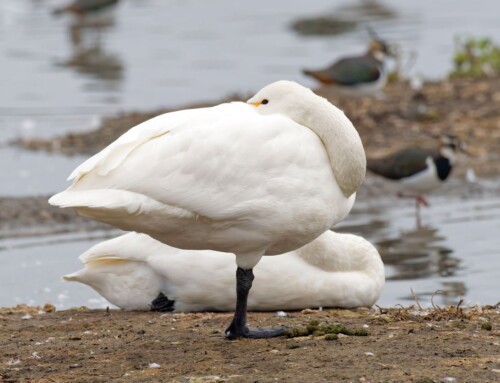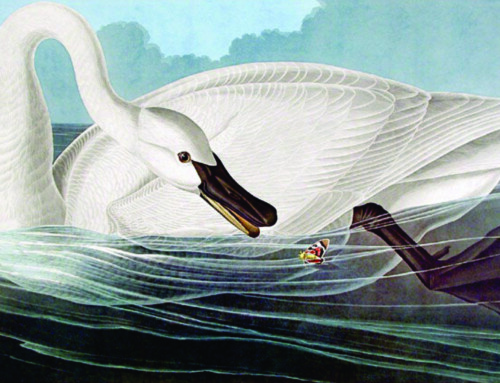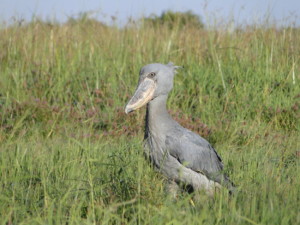 LINKED PAPER
LINKED PAPER
Changes in surface water drive the movements of Shoebills. Acácio, M., Mullers, R.H.E., Franco, A.M.A., Willems, F.J. & Amar, A. 2021 Scientific Reports. doi: 10.1038/s41598-021-95093-5 VIEW
The Shoebill (Balaeniceps rex) is an iconic wetland specialist, with a patchy distribution in central-eastern Africa, from South Sudan to Zambia. Shoebills inhabit permanent swampy wetlands with seasonal flooded grasslands, where they prey on fish in shallow waters or use floating vegetation as fishing sites (Guillet 1978, Mullers & Amar 2015). This species is categorised as Vulnerable by IUCN, with populations declining due to habitat degradation and loss, illegal bird trade and disturbance by humans. Despite being an extremely charismatic species with its pre-historic looks, the movement ecology of Shoebills was until now completely unknown, which is unsurprising given the remoteness of their habitat and the small number of Shoebills ringed in the past. We do not know, for example, if there is any connection between different Shoebill populations, important for genetic exchange.
To understand the movement and distribution of Shoebills, we deployed GPS devices on 11 Shoebills (10 juveniles and 1 adult) between 2011 and 2014 in the Bangweulu Wetlands, Zambia. Shoebills were tracked for up to 5 years, during which 6 individuals provided more than 1 year of data, maturing from juveniles to immatures, and 4 immatures provided more than 3 years of data, becoming adults. For this study, we only considered the movements of immature (2-3 year old) and adult birds (> 3 year old), as first year juveniles remained near the nest for a long period after fledging.
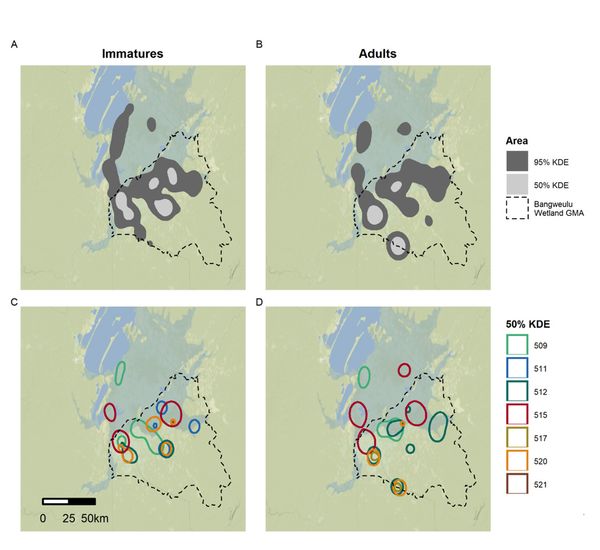
Figure 1 Cumulative 95% and 50% kernel density estimations for all tracked (A) immature and (B) adult Shoebills, and cumulative 50% kernel density estimation for each (C) immature and (D) adult individual, based on the GPS tracking periods indicated in Table 1. The dashed line indicates the border of the Bangweulu Wetlands Game Management Area.
When and where do Shoebills move to?
To answer this question, we calculated the distance Shoebills moved per day and estimated their annual home range areas using Kernel Density Estimations. To understand how movements changed throughout the year, we calculated the mean daily distances per month, for each individual and for each age group. We found that Shoebills in the Bangweulu Wetlands were largely sedentary, moving less than 3 km for 80% of days. Although the home range size was similar between adults and immatures, there was large individual variation (range 95% kernel for immatures: 233-2628 km2, range 95% kernel for adults 304-3375 km2).
The daily distances moved varied throughout the year, particularly for adult birds. During the breeding season (June-October), adults performed shorter movements (on average 1.1 km per day) but increased the daily distances towards the end of the breeding period and start of the rainy season (average of 10.5 km per day in December). Immature Shoebills, on the other hand, showed less variation in daily distances moved (minimum of 1.9 km in September, and maximum of 5.5 km per day in May).

Figure 2 Boxplots of the mean maximum daily distance per month, for individual immature and adult Shoebills, between 2011 and 2018. Data is organised to start at the beginning of the breeding season (May). The dashed line above the plot indicates the dry season (May to October) and the wet season (November to April). The shaded area highlights the period between October and December, with an increase of adult mean maximum daily distances.
Do Shoebills move in response to changes in surface water?
In wetlands, the distribution of surface water is one of the main determinants of species’ spatial distribution and individual movements (Donnelly et al. 2019). In common with many other areas occupied by Shoebills, the Bangweulu Wetlands undergoes dramatic changes in water levels between the dry (breeding season) and the wet season. We therefore hypothesised that changes in surface water drive the movements of Shoebills and that areas selected by Shoebills have similar surface water.
To test these hypotheses, we used satellite imagery to calculate the Normalized Difference Water Index (NDWI) (McFeeters 1996), a proxy for surface water. This index varies between 1, indicating open water features, and -1, indicating a dry area, on a gradient of surface water. To examine how the areas used by Shoebills changed during the start of the rainy season (October to January), we compared the NDWI of areas while Shoebills were present, with the NDWI of the same areas the week after Shoebills abandoned them. To examine if Shoebills select areas with similar surface water, we compared the NDWI of areas used by Shoebills the last week before abandonment with the NDWI of newly selected areas, the first week after arrival. We explored these questions for both adult and immature birds.
Our results show that between October and December, Shoebills occupied areas of low surface water availability (low NDWI values), which is likely the most available habitat. There were, however, differences in how adult and immature birds responded to changes in surface water. While adults seemed to abandon areas that became drier, immatures abandoned areas that became wetter, suggesting age-related differences in habitat use or foraging strategies. Moreover, the areas selected by Shoebills had the same surface water as the areas they were previously occupying, which suggests a selection for an optimal surface water level by this species.
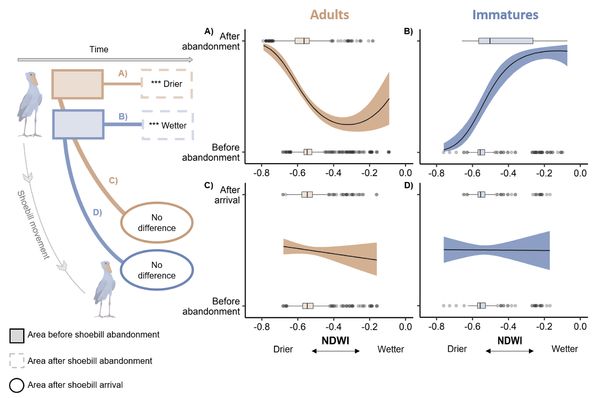
Figure 3 Diagram describing the analysed spatial and temporal relationships of Shoebill movements. The plots show the predicted mean daily NDWI values (solid line) and 95% confidence interval (shaded areas) for (A) adults and (B) immatures of ‘Areas’ before and after Shoebill abandonment, and for (C) adults and (D) immatures before Shoebill abandonment and after Shoebill arrival in a new ‘Area’. The boxplots display the observed values of daily mean NDWI. Brown colours indicate adult data and blue colours indicate immature data.
We suggest that the different movements in response to surface water between age-classes might be related to prey availability and optimal foraging conditions. Shoebills are typically solitary birds, but they occasionally concentrate in drying pools of water, where fish may become highly abundant (Guillet 1979). Immature and less efficient Shoebills may take advantage of this recession of the water level, which promotes high prey availability, to gain experience in capturing prey. Nonetheless, Shoebills also forage in deep water, using floating vegetation as fishing sites and then diving forward, described by Guillet (1979) as a “peculiar and complicated technique called collapsing”. Although birds using this technique have lower foraging success than on flooded grassland, the catfish caught in deeper waters are on average larger in deeper waters (Mullers & Amar 2015). Therefore, immature birds might prefer drier areas with higher abundance of relatively smaller prey, whereas adults having already mastered the highly specialised deep-water foraging technique, might prefer flooded areas with larger prey, and thus greater rewards per capture.
References
Donnelly, J.P., Naugle, D.E., Collins, D.P., Dugger, B.D., Allred, B.W., Tack, J.D. & Dreitz, V.J. 2019. Synchronizing conservation to seasonal wetland hydrology and waterbird migration in semi-arid landscapes. Ecosphere 10: e02758. VIEW
Guillet, A. 1979. Aspects of the foraging behaviour of the shoebill. Ostrich Journal of African Ornithology 50: 252-255. VIEW
McFeeters, S.K. 1996. The use of the normalized difference water index (NDWI) in the delineation of open water features. International Journal of Remote Sensing 17: 1425-1432. VIEW
Mullers, R.H.E. & Amar, A. 2015. Shoebill Balaeniceps rex foraging behaviour in the Bangweulu Wetlands, Zambia. Ostrich Journal of African Ornithology 86: 113-118. VIEW
Image credit
Top right: Shoebill Balaeniceps rex © Frank J. Willems.
If you want to write about your research in #theBOUblog, then please see here.




